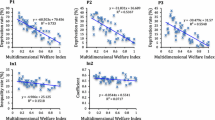Abstract
The purpose of this research is to study the effects of neoclassical trade liberalization policies enacted in India in 1991 to determine the effect on levels of poverty and income inequality. This research predicts that poverty and economic inequality will be reduced due to implementation of economic liberalization policies. The research uses empirical data from the National Sample Survey Organization (NSSO), in India and develops a regression model to determine the effects of economic liberalization on income inequality and absolute poverty. The results of the regression model suggest that income inequality and poverty decreased during the year liberalization policies were enacted, but is not statistically proven with enough confidence that liberalization is strongly correlated with a reduction in inequality and poverty. There is a weak statistical correlation that suggests inequality increased in the Indian urban sector, and decreased in the rural sector due to liberalization. In conjunction with a literature review where more robust data and econometric models are applied, the empirical analysis by complimented with the fact that in general income inequality decreased due to economic liberalization policies alone, holding all exogenous factors that affect income inequality constant. The literature review also confirms that poverty levels decreased with economic liberalization, holding all other exogenous factors that affect poverty constant. The implication of this research is that liberalization polices have been successful for overall development in India, and suggests that implementation of liberalization policies may be desirable in nations under similar circumstances as India in the era before its liberalization.
Access this chapter
Tax calculation will be finalised at checkout
Purchases are for personal use only
Similar content being viewed by others
References
Agarwal, V. (2007). The impact of trade liberalization on income inequality: A study of India. PhD thesis, George Mason University.
Agarwal, V., Paelinck, J., Reinher, K., & Stough, R. (2008). Trade liberalization and income inequality in India: A poisson distributed-lag analysis. Applied Econometrics and International Development, 8, 187–192.
Bajpai, N., & Sachs, J. D. (1997). India’s economic reforms: Some lessons from East Asia. The Journal of International Trade and Economic Development, 6, 135–164.
BBC. (1998). India: The economy. http://news.bbc.co.uk/2/hi/south_asia/55427.stm
Cali, M., Ellis, K., & te Velde, D. W. (2008). The contribution of services to development: The role of regulation and trade liberalisation. Overseas Development Institute (ODI) Project Briefings.
Chaudhary, C. M. (2005). India’s economic policies. Sublime Publications.
Chitke, R. P. (2011). Essays on regional economic growth in India. PhD thesis, University of Oklahoma.
Datt, G., & Ravallion, M. (2011). Has indias economic growth become more pro-poor in the wake of economic reforms? Oxford University Press.
Financial Express. (2004). Redefiningthe hindu rate of growth. http://www.financialexpress.com/news/redefining-the-hindu-rate-of-growth/104268/1
Fuller, D., & Stevenson, G. (2003). Consensus among economists revisited. Journal of Economic Review., 34(4), 369–387.
International Monetary Fund. (2002). What caused the 1991 currency crisis in India? IMF Staff Papers, 49(3).
International Monetary Fund. (2008). Global trade liberalization and the developing countries. http://www.imf.org/
International Monetary Fund. (2011). Report for selected countries and subjects. http://www.imf.org/
Jha, V. (2005). Trade adjustment study: India. www.unctad.info/upload/TAB/docs/.../india_study.pdf
Kar, S., & Marjit, S. (2008). Urban informal sector and poverty. International Review of Economics and Finance, 18(4), 631–642.
Kumar, U., & Mishra, P. (2008). Trade liberalization and wage inequality: Evidence from India. Review of Development Economics, 12(2), 291–311.
McCulloch, W., & Cirera. (2001). Trade liberalization and poverty: A handbook. Centre for Economic and Policy Research.
OECD. (2007). Economic survey of India, 2007. In Policy brief.
Pal, P., & Ghosh, J. (2007). Inequality in India: A survey of recent trends. Economic and Social Affairs.
Todaro, M., & Smith, S. (2009). Economic development. Pearson Education.
Tussie, D., & Aggio, C. (2003). Economic and social impacts of trade liberalization. Trade Analysis Branch – UNCTAD.
Wilkinson, & Pickett. (2009). The spirit level slides (Technical report). Penguin.
World Bank. (2011). World Bank data by country. http://www.worldbank.org/
Author information
Authors and Affiliations
Corresponding author
Editor information
Editors and Affiliations
Rights and permissions
Copyright information
© 2022 The Author(s), under exclusive license to Springer Nature Switzerland AG
About this chapter
Cite this chapter
Narayan, R., Narayan, S. (2022). Effects of Economic Liberalization on Poverty and Inequality in India – A Case Study of Pre-COVID-19 Period. In: Anandan, R., Suseendran, G., Chatterjee, P., Jhanjhi, N.Z., Ghosh, U. (eds) How COVID-19 is Accelerating the Digital Revolution. Springer, Cham. https://doi.org/10.1007/978-3-030-98167-9_11
Download citation
DOI: https://doi.org/10.1007/978-3-030-98167-9_11
Published:
Publisher Name: Springer, Cham
Print ISBN: 978-3-030-98166-2
Online ISBN: 978-3-030-98167-9
eBook Packages: Computer ScienceComputer Science (R0)




